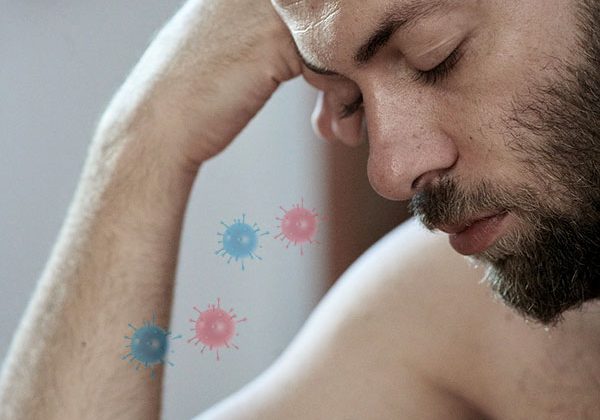A Case of Thyroid Cancer
by Barbara Ioni & Francesco Carelli
Diagnosis and timely therapeutic intervention permitted a correct surgical approach in a case of papillary carcinoma with lymph nodes metastases.
A 40 year old normal weight patient presented to the practice complaining of a loss of eight kilograms over the previous six months without any change in lifestyle or diet. With negative medical history and without any objective findings on examination, we decided to proceed with further investigations.
Complete blood count and ultrasound abdomen were normal however an ultrasound of the thyroid showed a 10×12 mms mixed echogenic nodule at the left lobe and a 15x13x12 mms one at the isthmus, with a partially exophytic development.
After thyroidectomy with left paratracheal and pretracheal lymphadenectomy, the histology confirmed the diagnosis of about a 3 cm left lobe papillary carcinoma extending from the isthmus, to the pyramidal lobe and the third superior right lobe, infiltrating the soft coatings of the perithyroid and locally the striated muscle at third medium left lobe. Furthermore metastases were spotted in 7/14. TNM was: pT3; N1a
The post operative course was uneventful except for an asymptomatic hypocalcemia. The patient was discharged on the second postoperative day on treatment with L-thyroxin 100mg, 1 tablet per day, Calcium carbonate 1g twice a day and Calcitriol 0.50mcg three times per day. While on therapy with sodium levothyroxine 150×5+100x2mcg per week and calcium carbonate 300mg once daily, three months later the patient was submitted to metabolic radiotherapy: 1850MBq of I-131 after thyrotropin alpha. The total body post dose scintigraphy pointed out two uptake areas: a cervical one and a sub-jugular one.
Following endocrinological inspection found a constant decrease of TSH (from 104 to 2,9), Ab-Tg 1254 U/ml, and lymph nodes with internal spots at echographic neck investigation. Our patient follow up continues with regular controls about every two months, and contemplates FT4,TSH,Tg,Ab-Tg, ionized Ca dosage, neck echographic test with clinic evaluation and therapy management.
Reflections
Every year twenty six thousand new cases of thyroid carcinoma are diagnosed in Europe, most of them of epithelial origin.1
More than 80% are represented by differentiated forms and, among these, papillary adenocarcinoma is the most frequent and the most detected incidentally by imaging studies.
Although thyroid cancer remains relatively rare, its incidence has been increasing progressively over the last decades.
Thyroid nodules are very common, in particular among the young generation or, in any case, among the working generation, therefore one is always in search of ultrasound characteristics that can identify most of the lesions that hold the highest risk of malignancy, especially in not palpable nodules.
Cappelli and his colleagues2 have been demonstrating how, with ultrasound confirmation, a long shaped nodule with a ratio of anteroposterior/transverse diameter more than or equal to 1,can be a good predictor of malignancy, independently of its dimension, but always associated to at least 2 more ultrasound characteristics such as micro calcification (most suspected are of the splash type), blurred margins, solid hypo-echoic appearance of nodule and its central hypervascularity.
The diagnostic criteria for thyroid nodules were also discussed at the last Congress of Italian Thyroid Association (AIT), with the introduction of two new tests: the elastography and the molecular diagnosis. Elastography is a special echography that indicates the nature of the nodule evaluating its resiliency, based upon the fact that the malignant coating is more rigid than the healthy one; the second one, to help the Fine needle aspiration cytology (FNAC) classic and enables it to increase its diagnostic precision up to 90%, is based upon a new rapid test for the screening of gene B-Raf mutation V600E that resulted in change in 40% of papillary carcinomas and protoncogene Ret/Ptc.
Among the new instruments utilized for this surgery, we have the bipolar coagulator and the ultrasound scalpel that stops micro haemorrhages during the operation, safeguarding nervous structures and thus reducing risks. Among the new techniques there is the MIVAT (mini invasive video-assisted thyroidectomy), developed in Italy. By using a camera, it ensures major precision and more restrained cuttings, but it cannot be used if the organ that has to be removed is too swollen or if there are adherences among coatings.
References 1.Borget I., Corone C et al. Sick leave for follow-up control in thyroid cancer patients:comparison between stimulation with thyrogen and thyroid hormone withdrawal. European Journal of Endocrinology (2007) 156 , 531-538 2. Cappelli C.,Castellano M., Pirola I., Gandossi E., De Martino E., Cumetti D., Agosti B., Agabiti Rosei E. Thyroid nodule shape suggests malignancy. European Journal of Endocrinology (2006) 155, 27-31




